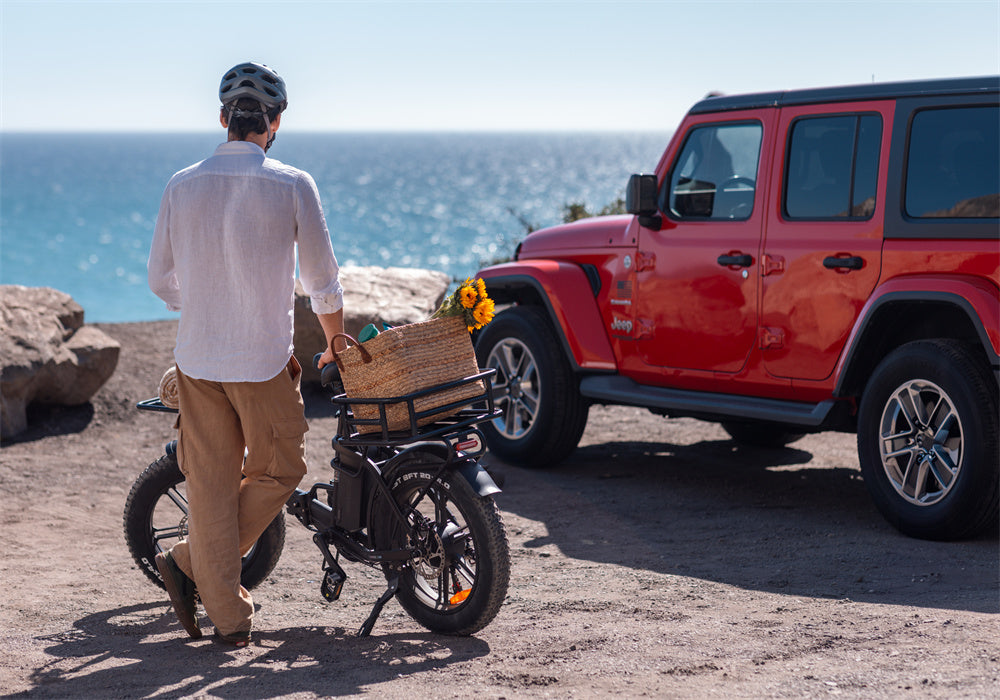Electric bikes, commonly referred to as e-bikes, are a modern twist on traditional bicycles. They offer the classic pedaling experience with an added electric boost, making them a favorite among commuters, cycling enthusiasts, and those looking for a leisurely ride. A question that often arises about e-bikes revolves around their top speed capabilities. How fast can these electrically assisted bikes really go?
TESWAY is known for offering a wide range of electric bikes, perfect for different types of riders. Whether you want a greener way to get around or just enjoy feeling the breeze as you go on new adventures, our fast e-bikes give you an exciting ride and a great option for getting around!
Here's a quick overview of the TESWAY e-bike!
|
Model |
Hub Motor (W) |
Torque (N.m) |
Battery |
Speed (mph) |
Class |
Price ($) |
|
S5 |
750 |
70 |
48V 30A |
28 |
2 |
1,199.99 |
|
S7 |
750 |
70 |
48V 20A |
28 |
2 |
1,099.99 |
|
Walker |
500 |
55 |
48V 12A |
25 |
2 |
1,099.99 |
|
Strider |
500 |
55 |
48V 12A |
25 |
2 |
899.99 |
Top Speeds Of Different Classes Of E-Bikes
In the United States, electric bicycles (e-bikes) are classified into three distinct categories based on their maximum speed and the method by which electric assistance is provided to the rider.
Class 1 Electric Bicycles
Class 1 e-bikes are equipped with a motor that provides assistance only when the rider is pedaling, and ceases to provide assistance when the bicycle reaches a speed of 20 miles per hour (mph). This type of e-bike is designed to augment human power, but not to completely replace it, which means the rider must be pedaling for the motor to engage. Class 1 e-bikes are widely accepted on bike paths and trails where traditional bikes are allowed, given their pedal-assist nature and moderate top speed.
They are ideal for riders looking for a boost on hills and during their commute, without reaching speeds that are too high for shared paths. When cruising through your neighborhood or along a scenic trail on a sunny weekend morning. These bikes are fantastic for leisurely rides, exploring new paths, or running errands around town.
The moderate speed ensures safety and compliance on most bike paths, making it a great option for a relaxing day out in nature or a casual commute to work. You get the benefit of exercise with the added convenience of electric assistance when you need it, without the intimidation of high speeds.

Class 2 Electric Bicycles
Class 2 e-bikes also have a top speed of 20 mph, but they differ from Class 1 e-bikes in that they are equipped with a throttle-assisted motor. This means the motor can propel the bike without the rider needing to pedal. The availability of a throttle makes class 2 e-bikes suitable for riders who may need or want the option to ride without pedaling. Despite this capability, the motor will not provide assistance beyond 20 mph, ensuring the bike remains in a safer speed range for most bike paths and urban environments.
With the throttle under your grip, you can effortlessly adjust your speed to match your immediate environment, whether you're dodging pedestrians in a crowded space or enjoying a quiet street at a leisurely pace. This type of e-bike suits those who value flexibility and comfort, offering a relaxed ride with the option to engage in pedaling for exercise or enjoyment whenever desired.
All TESWAY Ebikes are Class 2! Explore More!
Class 3 Electric Bicycles
Class 3 e-bikes offer pedal-assist up to 28 mph, catering to those who need or prefer a faster commute.Class 3 e-bikes are characterized by their higher maximum speed. These bikes are equipped with a motor that provides assistance only when the rider is pedaling, similar to Class 1, but the assistance continues until the bike reaches a speed of 28 mph.
Due to their higher speeds, Class 3 e-bikes are often equipped with additional safety features such as a speedometer and must be equipped with a braking system capable of bringing the bike to a halt from its top speed in a controlled manner. Class 3 e-bikes are typically regulated more strictly than Class 1 and 2, with restrictions on where they can be ridden, often being limited from certain bike paths and trails.
For adventurous riders, this means less time on the road and more time enjoying your destination, whether it's a distant cafe or a scenic overlook that's just a bit too far for slower bikes.
What Is The Best Electric Hybrid Bike?>>>
The Power Behind E-Bikes
At the center of what makes an e-bike zip along is its electric motor. This neat gadget boosts your pedaling, making it easier to go faster with less sweat. E-bikes come with motors that range from 250 to 750 watts. Think of watts like the motor's strength. More watts mean the bike can speed up faster and keep up its top speed more easily. It's like having a stronger push when you're riding.
Another key part of the e-bike is its battery. The battery's job is to keep the motor running. Its size, measured in watt-hours (Wh), is like how much gas you can put in a car. A bigger battery means you can ride at top speed for a longer time without running out of juice. A strong motor needs a big battery to keep it going.
A 500-watt motor on an e-bike can usually help you reach speeds of up to 20 miles per hour without needing to pedal like crazy. This is great for a smooth ride around town or even for a bit of fun off-road. Now, when you bump up to a 750-watt motor, that's when things get even speedier. An e-bike with this kind of power can help you zoom up to speeds of around 28 miles per hour with the same amount of pedal effort. This is especially handy if you're looking to get somewhere fast or enjoy the thrill of a quicker ride.
Tips for Enhancing Your E-Bike's Speed
While there are legal limits to how fast your e-bike can go, there are strategies to ensure you're maximizing its speed potential. Here are some tips:
Maintain Optimal Tire Pressure: Properly inflated tires can significantly reduce rolling resistance, making it easier and faster to ride. Check your tire pressure regularly to ensure it's at the ideal level for your e-bike.
Keep Up with Regular Maintenance: Just like any vehicle, an e-bike requires regular maintenance to perform at its best. This includes checking the motor and battery, as well as the bike's chain, brakes, and tires. A well-maintained e-bike can offer smoother, faster rides.
Adjust Your Riding Style: Learning how to effectively use your e-bike's different power modes can make a big difference. Knowing when to conserve battery power and when to use it for speed can help you manage longer, faster rides efficiently.
A Last Word
The speed of electric bicycles is influenced by a multitude of factors, ranging from the motor's power and the battery's capacity to the rider's weight and the bike's overall condition. Recognizing the perfect blend of speed and performance that matches your specific needs is crucial when selecting an e-bike. It's equally important to be aware of the local legislation governing e-bikes, as laws in some states clearly define the maximum speeds these bicycles can legally reach. Whether you're a commuter looking for an efficient way to navigate the city or an enthusiast seeking the thrill of speed, understanding these aspects can guide you in choosing the ideal electric bike.
Looking for an electric bicycle that combines quality, performance, and affordability? TESWAY offers a range of the best affordable electric bicycles designed to meet various needs and preferences, all while ensuring compliance with legal speed regulations. Discover your perfect ride with TESWAY and elevate your cycling experience today!
FAQs
What factors influence an electric bike's top speed?
The motor's wattage and the battery's capacity are the main factors. The motor provides the necessary power for acceleration and maintaining speed, while the battery's capacity affects how long the bike can sustain its top speed.
How can I legally increase my e-bike's speed?
While you can't legally modify your e-bike to exceed regulatory speed limits, maintaining optimal tire pressure, ensuring regular maintenance, and adjusting your riding style can help you maximize your e-bike's speed within legal limits.
Does the weight of the rider affect the e-bike's top speed?
Yes, the weight of the rider can impact the e-bike's performance. Heavier riders may find that their e-bike accelerates more slowly and might have a slightly reduced top speed compared to lighter riders, all else being equal. Regular maintenance and optimal use of power modes can help mitigate these effects.
Recommended Similar Articles
TESWAY Walker: Elevating Urban Commutes with Electric Innovation
TESWAY X5: Transform Your Urban Journey
Electric Bikes in Wet Conditions: Can You Ride an Ebike in the Rain?
What Is The Best Electric Hybrid Bike?
Electric Bike vs. Regular Bike: Which Is Perfect For Me?








Share:
How Much Are Electric Bike?
Best Price Electric Bikes You Could Buy!